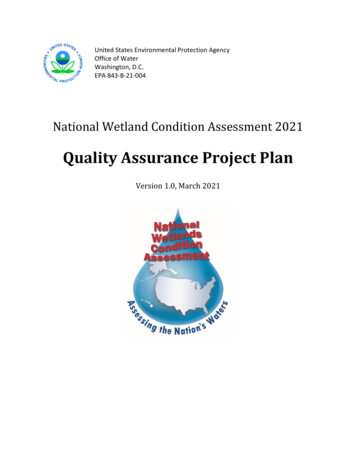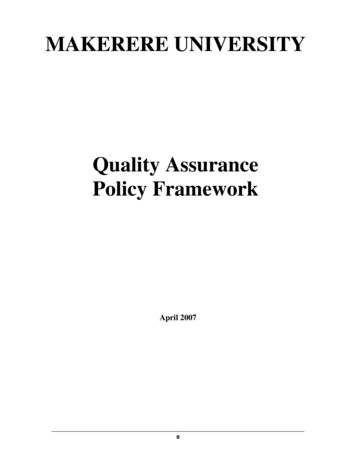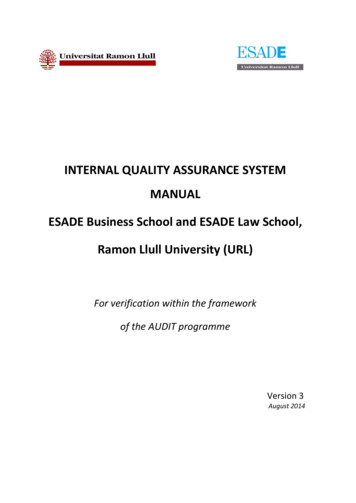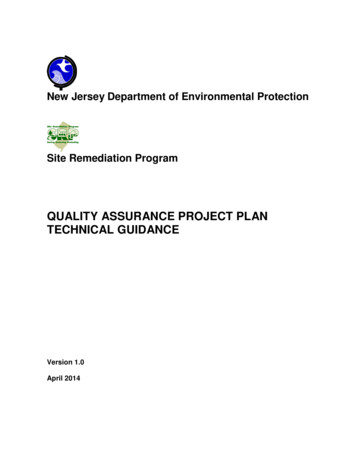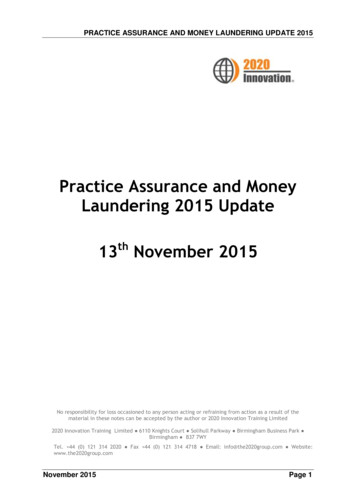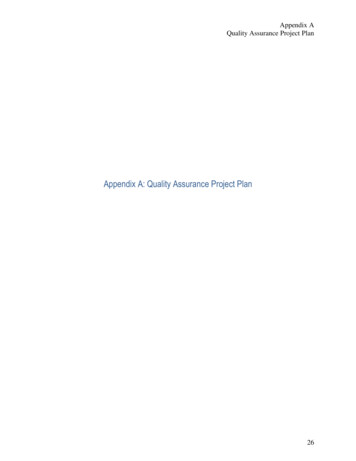
Transcription
Appendix AQuality Assurance Project PlanAppendix A: Quality Assurance Project Plan26
Appendix AQuality Assurance Project PlanA1 Approval PageBy signing this document, signatories acknowledge their respective organizations’ awareness ofand commitment to requirements contained in this Quality Assurance Project Plan (QAPP) inaccordance with roles and responsibilities as described in Section A4 Project/Task Organization.Texas Commission on Environmental Quality (TCEQ)Office of WaterWater Quality Planning DivisionPlanning and Implementation SectionSarah Bernhardt, Ph.D., Program ManagerDateGalveston Bay Estuary Program (GBEP)Lisa Marshall, Project Manager (PM)DateGBEPMichelle Krause, Quality Assurance Officer (QAO)DateGBEPOffice of Compliance and EnforcementMonitoring DivisionLaboratory and Quality Assurance (QA) SectionSharon Coleman, TCEQ QA ManagerDate27
Appendix AQuality Assurance Project PlanHouston-Galveston Area Council (H-GAC)Paniz Miesen, PMDateH-GACJean Wright, QAODateH-GACBill Hoffman, Clean Rivers Program (CRP) Data ManagerDateH-GACWill Merrell, GIS Data ManagerDateH-GACEastex Environmental Laboratory (Eastex)Date:Pam HickmanEastex Lab ManagerDate:Daniel BowenLab28
Appendix AQuality Assurance Project PlanA2 Table of ContentsA1 Approval Page . 27A2 Table of Contents . 29List of Acronyms . 30A3 Distribution List . 31A4 Project/Task Organization. 33Figure A4.1 Organization Chart . 36A5 Problem Definition/Background . 37A6 Project/Task Description . 39A7 Quality Objectives and Criteria. 46A8 Special Training/Certification . 49A9 Documents and Records. 49Table A9.1a Project Documents and Records for H-GAC . 50B1 Sampling Process Design . 52B2 Sampling Methods. 53B3 Sample Handling and Custody . 55B4 Analytical Methods . 56B5 Quality Control . 57Sampling Quality Control Requirements and Acceptability Criteria . 58B6 Instrument/Equipment Testing, Inspection and Maintenance . 59B7 Instrument/Equipment Calibration and Frequency . 59B8 Inspection/Acceptance of Supplies and Consumables . 60B9 Non-Direct Measurements . 60B10 Data Management . 62C1 Assessments and Response Actions . 63Table C1.1 Assessments and Response Actions . 65C2 Reports to Management . 64Table C2.1 QA Management Reports . 64D1 Data Review, Verification, and Validation . 66D2 Verification and Validation Methods . 66D3 Reconciliation with User Requirements . 66Appendix A: Work Plan/Scope of work . 68Appendix B: Data Management Plan . 76Appendix C: Field Data & Chain of Custody Sheets . 108Appendix D: Texas Stream Team . 112Bacteria SOP for EASYGEL Method. 112Appendix E: BIG’S Top Ten Prioritized Lists . 121Appendix F: Garmin Product Manual. 124Appendix G: Corrective Action Form . 129Appendix H: GBEP QAPP Amendment form . 13129
Appendix AQuality Assurance Project PlanList of p10TSWQSUSGSWWTFBacteria Implementation GroupCommunity and Environmental PlanningCorrective Action ReportCouncil of GovernmentsColony-Forming Unit of BacteriaClean Rivers ProgramContent Standards for Digital Geospatial MetadataData ManagerEnvironmental Protection AgencyFlow Duration CurveFederal Geographic Data CommitteeGlobal Positioning SystemGalveston Bay Estuary ProgramHouston-Galveston Area CouncilIllicit Discharge Detection and EliminationImplementation PlanLoad Duration CurveLand Use/Land CoverMost Probable NumberMunicipal Separate Storm Sewer SystemNational Environmental Laboratory Accreditation ProgramOnsite Sewage FacilityProject ManagerQuality Assurance/Quality ControlQuality Assurance Manual (or Manager)Quality Assurance OfficerQuality Assurance Project PlanQuality Assurance SpecialistQuality Management PlanStandard Operating ProcedureSurface Water Quality MonitoringSurface Water Quality Monitoring Information SystemTexas Commission on Environmental QualityTotal Maximum Daily LoadThe NELAC InstituteTexas Natural Resources Information SystemTop 2 Most Impaired/Top 2 Least Impaired ListsTop 5 Most Impaired/Top 5 Least Impaired ListsTop 10 Most Impaired/Top 10 Least Impaired ListsTexas Surface Water Quality StandardsUnited States Geological SurveyWastewater Treatment Facility30
Appendix AQuality Assurance Project PlanA3 Distribution ListTCEQP.O. Box 13087Austin, Texas 78711-3087Sharon Coleman, TCEQ QA Manager(512) 239-6340GBEP17041 El Camino Real, Suite 210Houston, TX 77058Lisa Marshall, GBEP PM(281) 486-1244Michelle Krause, GBEP QAO(281) 486-1246H-GACP.O. Box 22777Houston, TX 77227Paniz Miesen, PM(832) 681-2579Jean Wright, QAO(713) 499-6660Bill Hoffman, Data Manager(832) 681-2574Will Merrell, GIS Data Manager(832) 681-2551Eastex Environmental Laboratory (Eastex)P.O. Box 1089Coldspring, TX 77331Pam HickmanLaboratory ManagerDaniel BowenLaboratory31
Appendix AQuality Assurance Project PlanU.S. Environmental Protection Agency, Region 6Water Quality Division1445 Ross AvenueSuite # 1200Dallas, TX 75202-2733Teresita MendiolaRegion 6 Project Officer(214) 665-7144The H-GAC QAO will provide copies of this project plan and any amendments or revisions of this plan toeach person on this distribution list and to each sub-tier participant other than TCEQ and EPA staff. TheH-GAC QAO or PM will provide documentation of this transmittal to the TCEQ GBEP Project Managerwithin two weeks of QAPP approval. This documentation will be maintained as part of the H-GAC’squality assurance records and as part of the TCEQ project file.The TCEQ GBEP Project Manager is responsible for providing copies of the project plan and anyamendments or revisions of this plan to TCEQ and EPA staff. Copies must be provided within two weeksof QAPP approval, and documentation of this transmittal will be available for review and maintained aspart of the TCEQ project file.32
Appendix AQuality Assurance Project PlanA4 Project/Task OrganizationThe following is a list of individuals and organizations participating in the project with their specific rolesand responsibilities:GBEPSarah Bernhardt, Ph.D.GBEP Program ManagerThe TCEQ GBEP Program Manager is responsible for supervising the TCEQ’s GBEP Team. Oversees thedevelopment of QA guidance for the GBEP Team to ensure it is within pertinent frameworks of the TCEQ.Reviews and/or approves all GBEP projects, QA audit responses, QAPPs, agency Quality Management Plans(QMPs), corrective action reports (CARs), work plans, and contracts. Enforces corrective action where QAprotocols are not met. Ensures GBEP personnel are fully trained.Lisa MarshallGBEP PMThe TCEQ GBEP PM is responsible for ensuring that the project delivers data of known quality andquantity on schedule to achieve project objectives. PM is the primary point of contact between the HGAC and the TCEQ. Tracks and reviews deliverables to ensure that tasks in the work plan are completedas specified in the contract. Reviews and approves QAPPs and any amendments or revisions and ensuresproper distribution of approved/revised QAPPs to TCEQ participants and the EPA. Responsible forverifying that the QAPP is followed by the H-GAC. Notifies the TCEQ GBEP and GBEP ProgramManager of significant project nonconformances and corrective actions taken as documented in CARsand/or quarterly progress reports (QRPs).Michelle KrauseGBEP QAOGBEP reviews and approves QAPPs and any amendments or revisions. Responsible for verifying that theQAPP is followed by the H-GAC. Assists the GBEP Program Manager and GBEP PM on QA-relatedissues. Prepares and distributes annual audit plans. Conveys QA problems to appropriate TCEQmanagement. Monitors implementation of corrective actions. Coordinates and conducts audits. Ensuresmaintenance of QAPPs and audit records for the GBEP program.33
Appendix AQuality Assurance Project PlanHOUSTON-GALVESTON AREA COUNCIL (H-GAC)Paniz MiesenH-GAC PMThe H-GAC PM is responsible for ensuring that all tasks and other requirements in the contract areexecuted on time and with the quality assurance/quality control requirements as defined by the contractand in the project QAPP; assessing the quality of subcontractor/participant work; submitting accurate andtimely deliverables to the TCEQ GBEP PM; and coordinating attendance at conference calls, trainings,meetings, and related project activities with the TCEQ. Responsible for verifying that the QAPP isdistributed and followed by the H-GAC (including all subcontractors and/or sub-tier project participants).Coordinates C&E staff assigned to conduct the desk reviews, groundtruthing field activities, sampling,and data acquisition for this project.Jean WrightH-GAC QAOResponsible for coordinating development and implementation of the H-GAC’s QA program.Responsible for writing and maintaining QAPPs, annual updates, and amendments, and monitoring theirimplementation. Responsible for maintaining records of QAPP distribution, including appendices andamendments. Responsible for maintaining written records of sub-tier commitment to requirementsspecified in this QAPP. Responsible for identifying, receiving, and maintaining project quality assurancerecords. Responsible for compiling and submitting the QA report. Responsible for coordinating with theGBEP to resolve QA-related issues. Notifies the H-GAC PM and GBEP PM of particular circumstanceswhich deviate from requirements in the QAPP and may adversely affect the quality of data. Coordinatesthe research and review of technical QA material and data related to water quality monitoring systemdesign and analytical techniques. Conducts assessments of participating organizations during the life ofthe project as noted in Section C1. Coordinates and monitors nonconformances and corrective actions.Also implements or ensures implementation of corrective actions needed to resolve nonconformancesnoted during assessments.Bill HoffmanH-GAC Data ManagerResponsible for the acquisition, verification, and transfer of data to the H-GAC PM. Oversees datamanagement for the project. Provides the point of contact for the H-GAC PM to resolve issues related tothe data and assumes responsibility for the correction of any data errors. Coordinates with H-GAC GISData Manager on use of data for GIS analysis.Will MerrellH-GAC GIS Data ManagerResponsible for the GIS data acquisition, interpretation, and analysis as well as providing technicalguidance needed for the preparation of the project QAPP. Will oversee all GIS data processing, GISand/or GPS data review, data analysis, incorporation of data into Basin 11 database, and will make surethe minimum requirements/ objective/data are met. H-GAC GIS Data Manager will work with H-GACPM to address any GIS issues or concerns.34
Appendix AQuality Assurance Project PlanEastex Environmental Laboratory (Eastex)Pam HickmanLaboratory Director - Eastex Environmental Laboratory (Contract Lab)Responsible for producing quality analytical data for samples collected and submitted by H-GAC.Maintains verification of procedures establishing the level of quality. Responsible for sending data andCOC forms to H-GAC within time specified in contract.Daniel BowenEastex LabChecks training, competency, and re-training of technicians. Performs verification and validationprocedures to confirm quality data is issued to clients. Performs other QA/QC duties and checksassociated with lab activities. Resolves out-of-control issues. Conducts internal lab audits.Other Project PartnersLocal governments, consultants, non-profits and other local and regional stakeholders (e.g. City ofHouston Public Works, Bayou Preservation Association), particularly those involved in the BacteriaImplementation Group (BIG) may be invited to participate as part of a technical advisory work group.The work group will voluntarily assist the H-GAC project team with local knowledge of local conditionsand may be asked to lend support in the field. Project partners will work alongside and not independent ofH-GAC staff. Local partners will be determined during desk reviews and will be identified in reports.35
Appendix AQuality Assurance Project PlanFigure A4.1 Organization ChartKerry NiemannTCEQ SectionManagerSharon ColemanTCEQ QAManagerSarah BernhardtGBEPProgram ManagerLocal Partners(City of Houston,Bayou PreservationAssociation, etc.)Lines of ManagementLisa MarshallGBEP ProjectManagerMichelle KrauseGBEPPaniz MiesenH-GACProject ManagerJean WrightH-GAC QAOH-GAC StaffDesk Reviews, DataCollectionBill HoffmanH-GACData ManagerWill MerrellH-GAC GISData ManagerPam HickmanEastex LaboratoryManagerDaniel BowenEastex LaboratoryLines of Communication36
Appendix AQuality Assurance Project PlanA5 Problem Definition/BackgroundThe Bacteria Implementation Group (BIG) was formed in 2008, following the completed Total MaximumDaily Load (TMDL) study, to develop an implementation plan (I-Plan) that addresses the elevated levelsof bacteria in 72 bacteria-impaired segments in the region. The BIG project area drains to Galveston Bay,where a sizeable area of the Bay’s oyster producing waters are restricted to recreational harvest by theTexas Department of State Health Services due to elevated bacteria levels. Figure A5.1 presents the BIGproject area map. Contact recreation is the primary impairment or concern identified in this BIG regionand will be the focus of this project. The contact recreation standard uses indicator bacteria (E. coli andEnterococcus) as surrogates for the potential presence of human pathogens. Bacteria is known to comefrom a variety of sources (anthropogenic and wildlife) and is associated with land cover/land uses whichinclude but are not limited to agriculture and urban development run-off and wastewater conveyance andtreatment.This project will address the Non-point Source and Point Source action plans of the Galveston Bay Plan,a Comprehensive Conservation Management Plan of the Galveston Bay Estuary Program. Illicitdischarges were found by the BIG to be a potential source of bacteria impacting area streams. This projectwill identify potential bacteria discharges and seek to eliminate them by working with local jurisdictions.The Houston-Galveston Area Council (H-GAC) is a Council of Governments (COG), the regionalauthority for the Gulf Coast State Planning Region, and has been actively involved in regional waterquality planning and public outreach activities since the 1970’s. H-GAC is a member of the BIG and hastracked bacteria levels to develop the Top Ten Most/Top Ten Least Impaired Lists (Top 10 Lists), “MostWanted” (i.e. those impaired assessment units (AUs) with the highest geometric means relative to thestate standards for bacteria) and “Most Likely to Succeed” (i.e. impaired AUs with the lowest geometricmeans relative to the state standards for bacteria). A project map that includes the Top 10 Lists can befound in Figure A5.1. Tables of the Top 10 Lists can be found in Appendix F.H-GAC C&E staff will address ten targeted watersheds (five each from the Top 10 Lists) by prioritizingthe watersheds through desk reviews, groundtruthing, identifying elevated sources of bacteria in the fieldthrough sample collection and analysis, and reporting those elevated bacteria sources to local jurisdictionswhere the sources were found. H-GAC will not correct the sources but will work with those jurisdictionsto remove the sources. This project will demonstrate improved water quality and document the value of aprioritized watershed approach for correcting bacteria sources. Long-term AU water quality will beevaluated using CRP ambient monitoring not subject to this project. Results will be shared with BIGpartners and other municipalities, particularly Municipal Separate Storm Sewer System (MS4) operators,through presentations and print material to encourage prioritization during Illicit Discharge Detection andElimination (IDDE) programs.The purpose of this QAPP is to clearly delineate H-GAC’s QA policy, management, structure, andprocedures which will be used to acquire the needed data from the identified sources and to complete thedata analysis and land cover/land use comparisons. Data and results derived from this project will be usedto increase understanding of water quality impairments and concerns and the source of those impairmentsor concerns. Results from this project may also be used by the TCEQ to address implementation of theGalveston Bay Plan and support future implementation projects to reduce bacteria to meet contactrecreation standards in the Galveston Bay Watershed.37
Appendix AQuality Assurance Project PlanFigure A5.1 Project map depicting the BIG project area and Top Ten “Most Wanted” and Top Ten “Most Likely to Succeed”listed AUs.38
Appendix AQuality Assurance Project PlanA6 Project/Task DescriptionThis project will use data collected through both direct and non-direct means. To simplify and monitorprogress, this project has been split into three phases. Figure A6.1 delineates the three phases through aproject flow chart and describes the tasks contained within. A project timeline has been provided withFigure A6.2. A more detailed and updated project work plan can be found in Appendix A.Phase IIn Phase I of the project, H-GAC will conduct an initial desk review, Desk Review 1, of the Top 10 Liststo prioritize this list and pare it down to create a top five list for each top ten list. H-GAC will thenconduct a more thorough desk review, Desk Review 2, to refine these lists one step further. The resultingprioritized list of two from each top 5 lists will then be subjected to ground truth analysis.During Phase I, local project partners will be invited to participate in a technical work group to share theirextensive knowledge of subject AUs. Local partners might be asked to participate alongside H-GAC insurveys of the selected AUs. The goal is to remove sources of bacteria in waterways and catchment areaswhich local partners might have jurisdiction. Developing trust and input by local partners will potentiallyfacilitate future follow up actions to remove sources by these partners in Phase III of the project.Involvement of local partners will be detailed in project reports provided to the TCEQ.During Desk Review 1, an assessment unit spreadsheet will be created which will contain at minimum,AU descriptions, monitoring station ID(s), location of monitoring stations, bacteria concentration(geometric mean), WWTF outfall locations, and stormwater outfall locations for the Top 10 lists. GIS willbe used to capture aerial imagery for the AUs and conduct general geospatial analysis to determineaccessibility. Previously collected quality assured ambient monitoring data from H-GAC and its partners(through CRP), TCEQ SWQM Program, and the U.S. Geological Survey (USGS) will be gathered duringthis part of Phase I. All data collected by TCEQ regional personnel are covered under the SWQMProgram QAPP. The impaired watersheds will also be prioritized based on the I-Plan’s recommendationunder the Geographic Priority Framework for five criteria: Bacteria Level, Accessibility, Use Level,Implementation Opportunities, and Future Land Use Changes. If other criteria are determined as thisproject develops, those criteria will be written into the Final Report and made into a recommendation tothe BIG for revision of the BIG I-Plan. The Top 10 Lists will be pared down to create preferential top fivemost and top five least (Top 5) lists for further review.Under Desk Review 2, H-GAC will further refine the AU spreadsheet by defining the size of each AUcatchment, completing AU bacteria trends using historical data beginning with January 1, 2003, and ifsufficient data is available, complete load duration curves (LDCs) for the Top 5 Lists. GIS will be used tocomplete land use/land cover analysis (LU/LC), consider potential sources, and evaluate further theaccessibility to AU and catch basin. Completed analysis should be able to prioritize the Top 5 Lists downto the top two most and top two least (Top 2) lists.LDCs for the AUs will be calculated where feasible, should sufficient historic bacteria data and flow databe available. LDC and Flow Duration Curves (FDCs), a precursor in developing LDCs, will be calculatedand plotted for bacteria in each selected AU. An LDC is a graphical illustration that shows thecorresponding relationship between contaminant loadings and stream flow conditions in the AU. Whilesometimes considered as models, FDCs and LDCs are not in the truest sense models. Further they do notrequire calibration to measured data nor do they require validation to measured data, thus obviating thesetasks of typical model development and coverage of these tasks by a QAPP. An LDC is a simple andeffective first-step methodology to obtain data-based evaluations of the general relationship ofconcentrations to flow conditions, and allows for vary basic comparisons between LU/LC data.39
Appendix AQuality Assurance Project PlanLDCs assist in determining patterns in pollution loading (point sources, nonpoint sources, erosion, etc.)depending on the streamflow conditions. Based on the observed patterns, specific management measurescan be implemented that target a particular kind of pollutant source. Another main advantage of the LDCmethod is that it can also be used to evaluate the current impairment by determining the percent ofsamples that exceed the standard.The final step in Phase I will be to complete an AU Intensive Study by conducting ground truth analysisof the Top 2 Lists. Ground truth analysis will entail performing windshield surveys of the AU catchmentarea and waterway reconnaissance surveys where the AUs and tributaries are walked. Windshield andwaterway reconnaissance will be conducted using established data collection forms and checklistdeveloped by H-GAC. Example field data sheets and expected survey data collected can be found inAppendix C. Additionally, during the walks, bacteria screening samples will be collected at potentialoutfalls and suspected effluents to quickly establish areas of the AUs for follow-up monitoring duringPhase II. Field staff will track the windshield survey and walks using GPS handheld devices to log thepath traveled and collect waypoints for screening sample collection locations, additional outfall structurelocations, potential sources, and other project relevant observations for follow-up during Phase II andPhase III. Photographs will also be taken to document observations.During the initial waterway surveys, H-GAC will document pipe outfalls with dry weather effluentdischarges. All outfalls emitting effluent during dry weather will be screened for bacteria by collectingsamples for processing at H-GAC. H-GAC will follow Texas Stream Team (TST) protocols for collectingand analyzing screening bacteria samples as established in the TST procedures manual, chapter 4, andusing Coliscan Easygel method. The excised portion of procedure manual specific to TST bacteriasamples can be found in Appendix D. TST is a quality assured voluntary monitoring program managed byjoint collaboration between the Meadows Center for Water and the Environment at Texas StateUniversity, the TCEQ, and EPA. H-GAC is the lead for TST activities in the region and staff is certifiedto train and audit TST volunteers. Samples will be handled within the required holding time asdocumented in the TST procedures manual. Bacteria screening will help prioritize areas within the AUsfor further bacteria analysis during Phase II. A Preliminary Action Report documenting the results ofPhase I will be created at the end of Phase I (See Appendix A, Project Work Plan).Phase IIBacteria samples and field parameters will be collected following the established policies and proceduresof the CRP during Phase II. H-GAC is the CRP lead agency for the San Jacinto River Basin (Basin 10)and three associated coastal basins – the Trinity-San Jacinto (Basin 9), the San Jacinto-Brazos (Basin 11),and the Brazos-Colorado (Basin 13), which covers all of the BIG project area. Monitoring will be used tofirmly establish bacteria concentrations found during bacteria screening and to further refine sourceidentification and aid in tracking the source(s) of the impairment up the tributaries and ditches to thegreatest extent practicable. H-GAC will monitor the prioritized AUs during wet weather and dry weatherconditions by returning to suspected waypoints plotted during Phase I that exhibited elevated levels ofbacteria.40
Appendix AQuality Assurance Project PlanFigure A6.1 Project flow chart delineating phases and tasks.41
Appendix AQuality Assurance Project PlanAll sampling and laboratory analysis methods are specified in H-GAC’s Texas CRP FY 2016-2017Regional Monitoring Activities Quality Assurance Project Plan (QAPP) as well as all past TCEQapproved QAPPs, revisions, and amendments. The collection and qualification of the Texas CRP datacollected in the H-GAC region are addressed in the H-GAC’s CRP QAPP found at gional-quality-assurance-project-plan.aspx. All bacteria samplesand conventional field parameters collected will follow this plan. Sample field data sheets can be found inAppendix C. Bacteria samples collected during Phase II will be analyzed at a NELAP certified laboratoryand will be processed within the required holding time as noted in footnotes to Table A7.1b on page 22.Bacteria samples will be analyzed using IDEXX Colilert method.The locations with high concentrations of bacteria will then be identified and plotted with GPS for useduring Phase III. A Source Identification Report will document the results of Phase II (See Appendix A,Project Work Plan).Phase IIIIn Phase III of the project, H-GAC will direct any project findings to the appropriate jurisdiction forfurther investigation. Additionally, any potential sources identified through the desk review and fieldground truth analysis will be directed to local jurisdictions. H-GAC will not have any role in removing orremediating any bacteria source, determining the specific type of action needed or taken, nor providingproject funding to local jurisdictions for implementing any identified action. H-GAC will not nor has theauthority to require any action be taken by the local jurisdiction.H-GAC will attempt to track implementation carried out by the local jurisdiction by documenting anyremedial actions carried out to remove or modify the elevated effluent sources. Once sources have
NELAP National Environmental Laboratory Accreditation Program OSSF Onsite Sewage Facility PM Project Manager QA/QC Quality Assurance/Quality Control QAM Quality Assurance Manual (or Manager) . The H-GAC QAO will provide copies of this project plan and any amendments or revisions of this plan to

